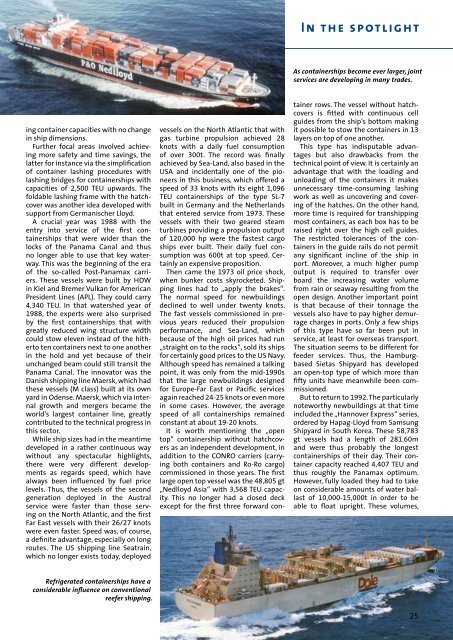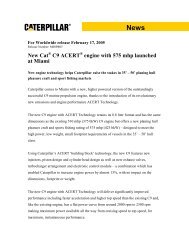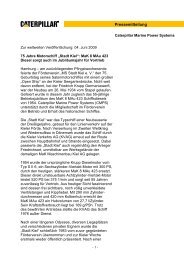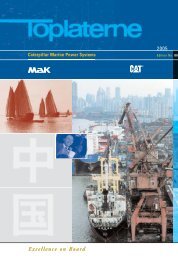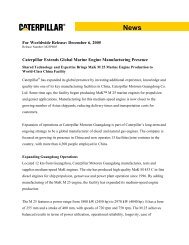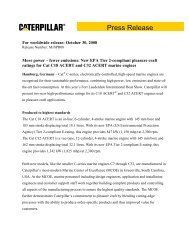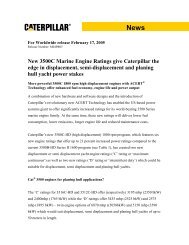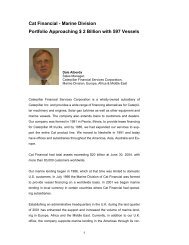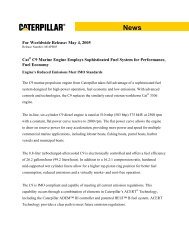Caterpillar Marine - Marine Engines Caterpillar
Caterpillar Marine - Marine Engines Caterpillar
Caterpillar Marine - Marine Engines Caterpillar
You also want an ePaper? Increase the reach of your titles
YUMPU automatically turns print PDFs into web optimized ePapers that Google loves.
ing container capacities with no change<br />
in ship dimensions.<br />
Further focal areas involved achieving<br />
more safety and time savings, the<br />
latter for instance via the simplification<br />
of container lashing procedures with<br />
lashing bridges for containerships with<br />
capacities of 2,500 TEU upwards. The<br />
foldable lashing frame with the hatchcover<br />
was another idea developed with<br />
support from Germanischer Lloyd.<br />
A crucial year was 1988 with the<br />
entry into service of the first containerships<br />
that were wider than the<br />
locks of the Panama Canal and thus<br />
no longer able to use that key waterway.<br />
This was the beginning of the era<br />
of the so-called Post-Panamax carriers.<br />
These vessels were built by HDW<br />
in Kiel and Bremer Vulkan for American<br />
President Lines (APL). They could carry<br />
4,340 TEU. In that watershed year of<br />
1988, the experts were also surprised<br />
by the first containerships that with<br />
greatly reduced wing structure width<br />
could stow eleven instead of the hitherto<br />
ten containers next to one another<br />
in the hold and yet because of their<br />
unchanged beam could still transit the<br />
Panama Canal. The innovator was the<br />
Danish shipping line Maersk, which had<br />
these vessels (M class) built at its own<br />
yard in Odense. Maersk, which via internal<br />
growth and mergers became the<br />
world‘s largest container line, greatly<br />
contributed to the technical progress in<br />
this sector.<br />
While ship sizes had in the meantime<br />
developed in a rather continuous way<br />
without any spectacular highlights,<br />
there were very different developments<br />
as regards speed, which have<br />
always been influenced by fuel price<br />
levels. Thus, the vessels of the second<br />
generation deployed in the Austral<br />
service were faster than those serving<br />
on the North Atlantic, and the first<br />
Far East vessels with their 26/27 knots<br />
were even faster. Speed was, of course,<br />
a definite advantage, especially on long<br />
routes. The US shipping line Seatrain,<br />
which no longer exists today, deployed<br />
Refrigerated containerships have a<br />
considerable influence on conventional<br />
reefer shipping.<br />
vessels on the North Atlantic that with<br />
gas turbine propulsion achieved 28<br />
knots with a daily fuel consumption<br />
of over 300t. The record was finally<br />
achieved by Sea-Land, also based in the<br />
USA and incidentally one of the pioneers<br />
in this business, which offered a<br />
speed of 33 knots with its eight 1,096<br />
TEU containerships of the type SL-7<br />
built in Germany and the Netherlands<br />
that entered service from 1973. These<br />
vessels with their two geared steam<br />
turbines providing a propulsion output<br />
of 120,000 hp were the fastest cargo<br />
ships ever built. Their daily fuel consumption<br />
was 600t at top speed. Certainly<br />
an expensive proposition.<br />
Then came the 1973 oil price shock,<br />
when bunker costs skyrocketed. Shipping<br />
lines had to „apply the brakes“.<br />
The normal speed for newbuildings<br />
declined to well under twenty knots.<br />
The fast vessels commissioned in previous<br />
years reduced their propulsion<br />
performance, and Sea-Land, which<br />
because of the high oil prices had run<br />
„straight on to the rocks“, sold its ships<br />
for certainly good prices to the US Navy.<br />
Although speed has remained a talking<br />
point, it was only from the mid-1990s<br />
that the large newbuildings designed<br />
for Europe-Far East or Pacific services<br />
again reached 24-25 knots or even more<br />
in some cases. However, the average<br />
speed of all containerships remained<br />
constant at about 19-20 knots.<br />
It is worth mentioning the „open<br />
top“ containership without hatchcovers<br />
as an independent development, in<br />
addition to the CONRO carriers (carrying<br />
both containers and Ro-Ro cargo)<br />
commissioned in those years. The first<br />
large open top vessel was the 48,805 gt<br />
„Nedlloyd Asia“ with 3,568 TEU capacity.<br />
This no longer had a closed deck<br />
except for the first three forward con-<br />
In the spotlight<br />
As containerships become ever larger, joint<br />
services are developing in many trades.<br />
tainer rows. The vessel without hatchcovers<br />
is fitted with continuous cell<br />
guides from the ship‘s bottom making<br />
it possible to stow the containers in 13<br />
layers on top of one another.<br />
This type has indisputable advantages<br />
but also drawbacks from the<br />
technical point of view. It is certainly an<br />
advantage that with the loading and<br />
unloading of the containers it makes<br />
unnecessary time-consuming lashing<br />
work as well as uncovering and covering<br />
of the hatches. On the other hand,<br />
more time is required for transhipping<br />
most containers, as each box has to be<br />
raised right over the high cell guides.<br />
The restricted tolerances of the containers<br />
in the guide rails do not permit<br />
any significant incline of the ship in<br />
port. Moreover, a much higher pump<br />
output is required to transfer over<br />
board the increasing water volume<br />
from rain or seaway resulting from the<br />
open design. Another important point<br />
is that because of their tonnage the<br />
vessels also have to pay higher demurrage<br />
charges in ports. Only a few ships<br />
of this type have so far been put in<br />
service, at least for overseas transport.<br />
The situation seems to be different for<br />
feeder services. Thus, the Hamburgbased<br />
Sietas Shipyard has developed<br />
an open-top type of which more than<br />
fifty units have meanwhile been commissioned.<br />
But to return to 1992. The particularly<br />
noteworthy newbuildings at that time<br />
included the „Hannover Express“ series,<br />
ordered by Hapag-Lloyd from Samsung<br />
Shipyard in South Korea. These 58,783<br />
gt vessels had a length of 281.60m<br />
and were thus probably the longest<br />
containerships of their day. Their container<br />
capacity reached 4,407 TEU and<br />
thus roughly the Panamax optimum.<br />
However, fully loaded they had to take<br />
on considerable amounts of water ballast<br />
of 10,000-15,000t in order to be<br />
able to float upright. These volumes,<br />
25


